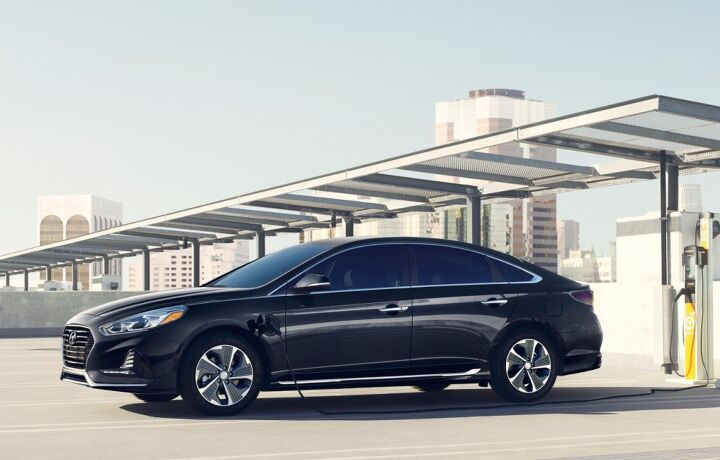Plug-in or Not, Hyundai Doesn't Want to Be Seen as the Expensive Choice

Exclusivity is not a word often associated with Hyundai, and with good reason. Like Nissan (but even more so), Hyundai’s reputation is built on a foundation of mass-produced vehicles with inherent value. And, even in the world of green cars, it seems that game plan can’t change.
So, it’s no surprise to see Hyundai take a hatchet to the price of its 2018 Sonata Plug-in Hybrid. In dropping the model’s entry price by $1,350 and adding one mile of electric driving range, Hyundai hopes it’s enough to attract the attention of would-be buyers. It needs to. In June, the model sat at 21st place on the public’s PHEV shopping list.
Starting now, a Sonata PHEV will set you back $33,350 before a $885 destination charge, while the Limited model grows $250 to $38,850 before destination.
For the base sticker, you’ll see the same 2.0-liter inline four and 50 kWh electric motor, the latter of which is good for 67 horsepower. The transmission remains a six-speed automatic. Hyundai now claims an EV driving range of 28 miles, up from the 27 advertised when the 2018 model debuted at the Chicago Auto Show. Any improvement is a good one, we suppose.
While cutting the entry price obviously adds value to the base model, the Limited’s slight price hike brings many new features aboard — LED headlights with “Dynamic Bending Light,” automatic emergency braking with pedestrian detection, a heated steering wheel, Driver Attention Alert, a wireless charging pad, and a USB port for rear seat passengers.
In a market awash with plug-ins, how has the Sonata fared? Not well, compared to other low-priced PHEVs. Granted, the 2018 model launched well after its Hybrid sibling, meaning that buyers could only source the old-style previous-generation model (even as the stock gasoline-only Sonata’s new design became old hat).
In June, Hyundai sold just 62 Sonata Plug-in Hybrids, a year-over-year drop of 29.5 percent. Over the first half of 2018, the model’s volume shrank by 28.9 percent. Even the plug-in version of the Kia Optima sells better. Year to date, Ford sold more than ten times as many Fusion Energi sedans.
The base Fusion Energi SE, which carries a range of 21 electric miles, stickers for $31,400 before destination — nearly two grand less than the new, cheaper Sonata PHEV.
[Images: Hyundai]

More by Steph Willems
Latest Car Reviews
Read moreLatest Product Reviews
Read moreRecent Comments
- Zerofoo @VoGhost - The earth is in a 12,000 year long warming cycle. Before that most of North America was covered by a glacier 2 miles thick in some places. Where did that glacier go? Industrial CO2 emissions didn't cause the melt. Climate change frauds have done a masterful job correlating .04% of our atmosphere with a 12,000 year warming trend and then blaming human industrial activity for something that long predates those human activities. Human caused climate change is a lie.
- Probert They already have hybrids, but these won't ever be them as they are built on the modular E-GMP skateboard.
- Justin You guys still looking for that sportbak? I just saw one on the Facebook marketplace in Arizona
- 28-Cars-Later I cannot remember what happens now, but there are whiteblocks in this period which develop a "tick" like sound which indicates they are toast (maybe head gasket?). Ten or so years ago I looked at an '03 or '04 S60 (I forget why) and I brought my Volvo indy along to tell me if it was worth my time - it ticked and that's when I learned this. This XC90 is probably worth about $300 as it sits, not kidding, and it will cost you conservatively $2500 for an engine swap (all the ones I see on car-part.com have north of 130K miles starting at $1,100 and that's not including freight to a shop, shop labor, other internals to do such as timing belt while engine out etc).
- 28-Cars-Later Ford reported it lost $132,000 for each of its 10,000 electric vehicles sold in the first quarter of 2024, according to CNN. The sales were down 20 percent from the first quarter of 2023 and would “drag down earnings for the company overall.”The losses include “hundreds of millions being spent on research and development of the next generation of EVs for Ford. Those investments are years away from paying off.” [if they ever are recouped] Ford is the only major carmaker breaking out EV numbers by themselves. But other marques likely suffer similar losses. https://www.zerohedge.com/political/fords-120000-loss-vehicle-shows-california-ev-goals-are-impossible Given these facts, how did Tesla ever produce anything in volume let alone profit?



































Comments
Join the conversation
I would gladly pay more for more horsepower. I imagine a bigger motor + battery would cover that price drop, add range, and give these kinds of cars decent acceleration without affecting gas mileage. I want a hybrid for my next car, but it's gotta run a 14 second quarter mile and burn regular gas. I honestly don't think such a car exists.
Unless gas prices go up more (and stay) up, most drivers (not in high gas price areas) won't see a return on a PHEV. Even a regular hybrid system take years to see a return; however, a 48V mild hybrid system would benefit the typical daily driver.